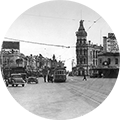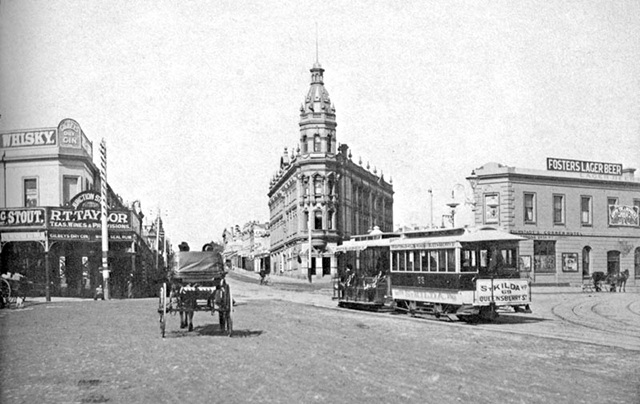St Kilda Junction by the 1900s had long been transformed into an urban environment. The smell of eucalyptus after rain, the sounds of squawking flocks of water birds flying over head and the sight a mobs of kangaroos moving through the open woodlands and grass lands of the early 1840s was replaced by a network of road and structures ever increasing in size and complexity, the sound of rattling of cable trams and other traffic and the air was soon to be dominated by the smell of gasoline.
The Junction at the end of the Nineteenth-century had grown and taken on an imperious persona, at-least when the occasion required it. In 1901 a large crowd gathered at the Junction to welcome the Duke and Duchess of York who landed at St Kilda pier and made their way along Fitzroy Street to the Junction where there was a large arch welcoming the royal couple.1 Before regular air transportation many visitors; royals, new governors and other dignitaries or celebrities landed at St Kilda pier. From St pier important visitors usually made their way in a procession to St Kilda Junction, then along St Kilda Road, usually ending at the Melbourne Town Hall or to Government House. In this period the Junction could be a place where people could show their loyalty to ‘queen and country’, capture a glimpse of the famous as they passed by, reveal in the associated pageantry and enjoy some time off from the normal routine of life.
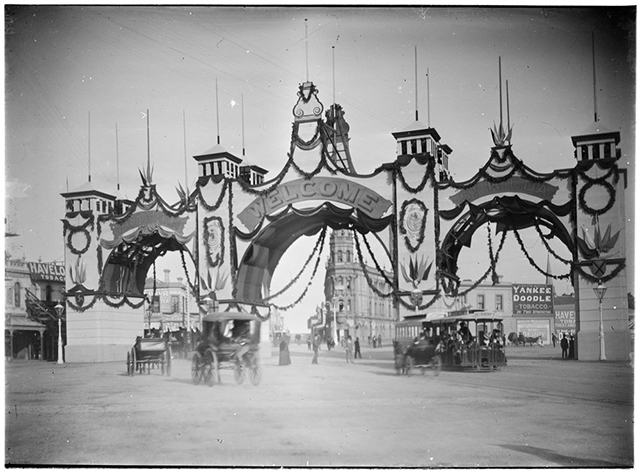
This arch was erected over the Junction to celebrate
the visit of the Duke and Duchess of York 1901
By the turn of the century St Kilda had become a holiday and recreation destination. In 1912 the iconic Luna Park was opened near the St Kilda Esplanade. Luna Park when it opened was the newest, greatest and best amusement park in the world.2 St Kilda offered a lot for locals and visitors a like, a fun park, beaches, theatres, dance halls, and sea baths. St Kilda as a tourist designation was strongly promoted as can be seen in publications such as St Kilda by the Sea: 1915-16 annual.
Many of the visitors to St Kilda were channelled to these facilities via the Junction.3 A popular mode of transport at this time was the cable tram service. Cable trams, cars, horse and carts and pedestrians all competed for use of the Junction as it continued to as a busy intersection through the first decades of the Twentieth-century.
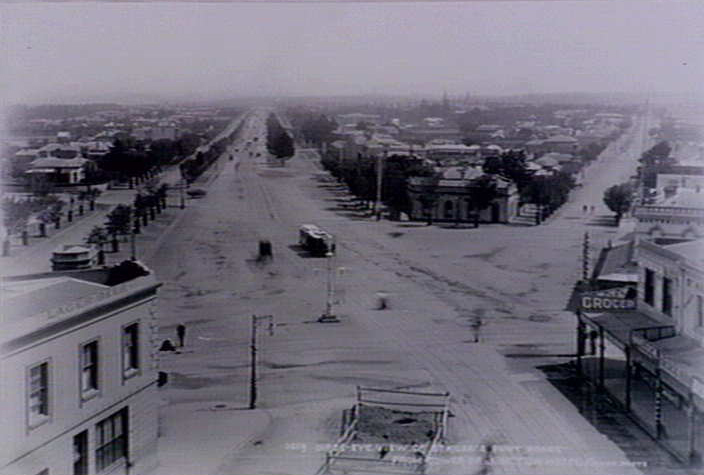
View from the Junction Hotel of the Junction and Cable Tram 1919
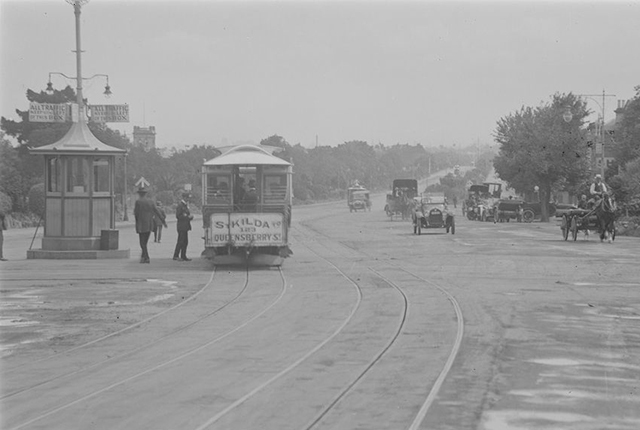
Cable tram at St Kilda Junction looking towards St Kilda Road ca 1920s
Advances in mass transit technology and the growing population which has beginning to strain the cable tram system resulted in the gradual replacement of cable trams the newer and more efficient technology of electric trams.4 The conversion began on the 29 August 1925 with the closure of the first cable tram line, the Windsor to St Kilda Esplanade.
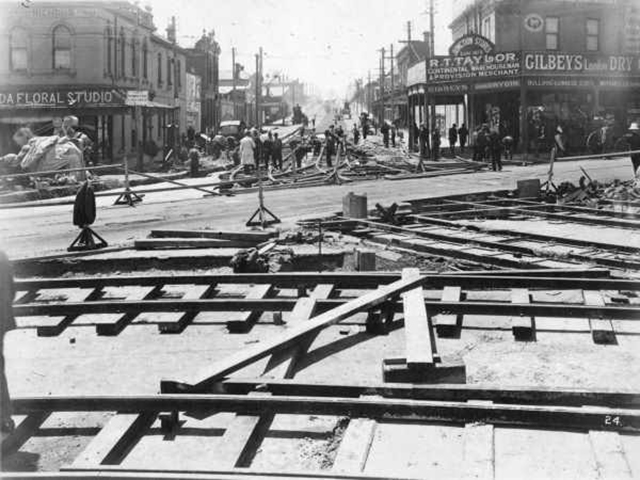
Installing new tracks for the electric trams at St Kilda Junction ca 1925
Wellington Street is in the background
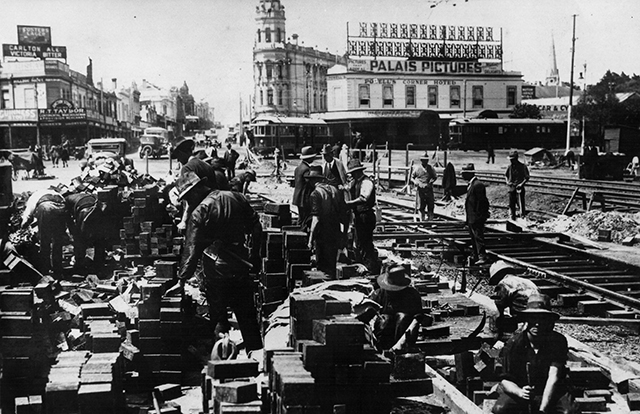
Tram track work at St Kilda Junction ca 1925
It was reported in The Argue newspaper (Saturday, 29 August 1925) that work would commence on the Monday the 30th of August and was estimated to take seven months.5 In 1929 a 'crows-nest' control box was installed at the Junction on the corner of Wellington Street to better control the passing trams.6 This same control box is now housed in the Melbourne Tram Museum.
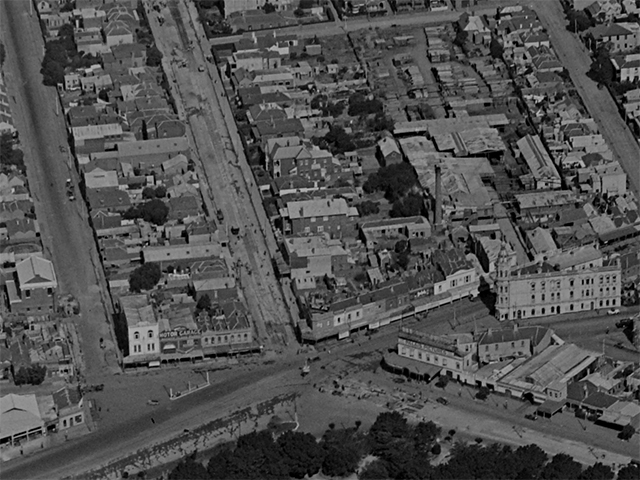
A aerial photograph of St Kilda Junction looking east,
the conversion of the Wellington Street cable tram line is evident, 1925
The conversion of the whole cable system to electricity continued until 1940 when the last cable tram line was finally closed. The Windsor to St Kilda Esplanade line ran down Wellington Street, through the Junction and into Fitzroy Street and then the Esplanade.7
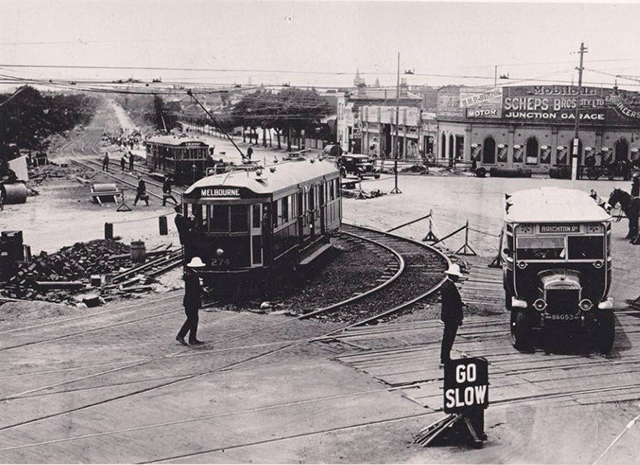
Tram and Bus making use of the Junction ca 1925
Also in 1925 the Metropolitan Town Planning Commission published its first report which identified St Kilda Junction as at 'bottleneck'. The report proposed the widening Wellington and High Streets to elevate the strain on the Junction caused by the demands of increasing traffic (of multiple types).8 The Junction was also developing reputation at this time not only as a 'traffic bottleneck' but also as location to obtain ‘sly grog’, the popularity of this illicit beverage made 'making, distribution, selling and buying, not to mention drinking off ' almost a Melbournian institution.9 In the minds of many the Junction became readily associated with the fame, notoriety and demand for 'sly grog'. The Junction's reputation was beginning to tarnish.
In the 1930s the Great Depression exacerbated the fading fortunes of St Kilda and put stop to many of the plans for Melbourne proposed by the Metropolitan Town Planning Commission. St Kilda became an epicentre for many of Melbourne’s social problems, crime, prostitution and alcohol and drug abuse. Cocaine could be bought around St Kilda Junction at this time and it was a known haunt for female prostitutes.10
Managing the traffic of the Junction was also an issue in the 1930s as identified by Anne Longmire who states, ‘police could not continuously man the Junction because of a lack of personnel … the Council constructed a safety zone at the Junction in 1935. … Congestion was relieved somewhat in November 1936 when gates, which blocked the road through Albert Park, were left open after sunset in order to improve access to the city … ’. Traffic lights were first installed at the Junction in 1939 but agitation had begun about solving the traffic bottleneck created by St Kilda Road running into the narrower High Street.11
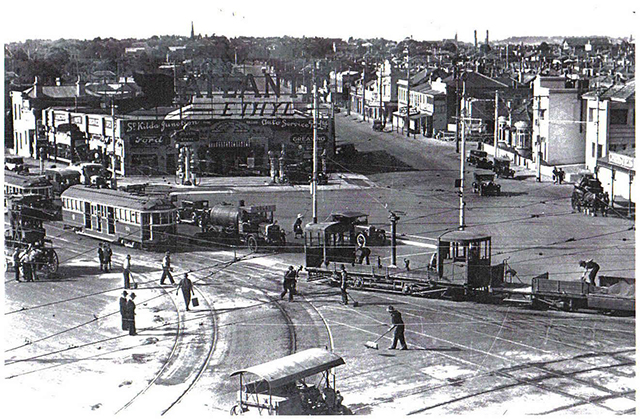
St Kilda Junction, in the background is the Junction Petrol Station
which was a feature of the Junction for many years ca 1934
During the Second World War the Junction was packed with American service personnel heading towards St Kilda. St Kilda was favoured destination of the service men, its dance halls, theatres, pubs, gambling and ‘working’ girls being major attractions.12
The first half of twentieth century saw the emergence of the Junction’s most enduring characteristics; congested traffic. Trams, horse and carts, cars, trucks and pedestrians; all competing for access.
Footnotes
- J. B Cooper, The History of St Kilda: Volumes 1 & 2 From Its First Settlement To A City: 1840 to 1930, Melbourne, 1931, Volume 2, pp. 299-300.
- A. M. Longmire, The History of St Kilda: Volume 3 The Show Goes On: 1930 to July 1983, Hawthorn, 1989, p. xi.
- Visitors’ and Tourist Guide to St Kilda by the Sea: Train and Tram – Railway Service in St Kilda by the Sea 1915-16 Annual, Prahran, 1915, pp. 161-168.
- State Library of Victoria, 1925 photograph of tram track reconstruction at St Kilda Junction. The photograph shows the installation of tracks for electric trams, which indicates the period when the Junction was converted from cable trams to electric trams. This was a major change in public transport technology that was occurring across Melbourne between 1924 and 1940.
- 'St. Kilda Road Trams, conversion of cable line, Work begins on Monday', The Argus, Saturday August 29, 1925, p. 31.
- 'Tramway "Crows-Nest", The Argus, Wednesday March 6, 1929, p. 5.
- Yarra Trams, Melbourne Trams, Website, at http://www.yarratrams.com.au/about-us/our-history/trams-in-melbourne/, accessed 6 January 2014
- Melbourne Metropolitan Town Planning Commission, Melbourne: First Report of the Metropolitan Town Planning Commission, 1925, p. 38.
- ‘Sly Grog at Junction', The Age, Thursday 26 February 1926, p. 26.
- Longmire, pp. 18-21.
- ibid. p. 12.
- J. Rowe, Street Walking Blues: Sex work, St Kilda and the Streets, Melbourne, 2006, pp. 4-5.

